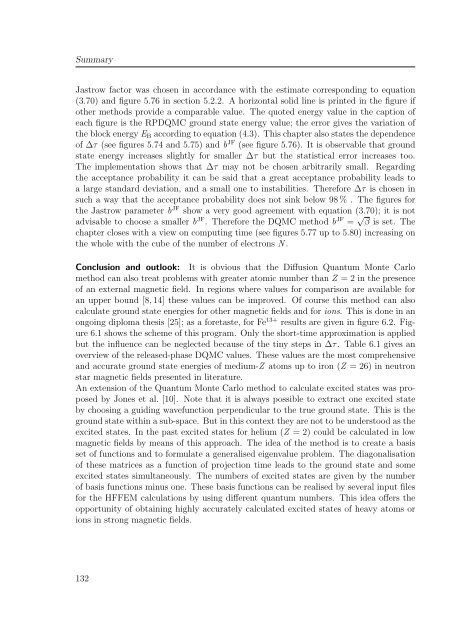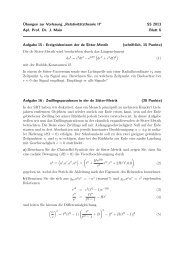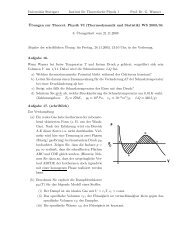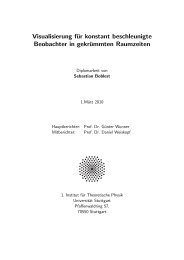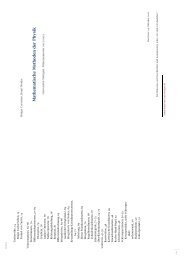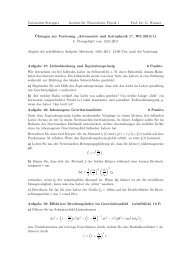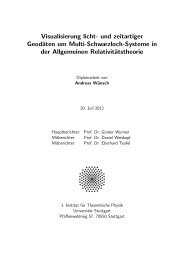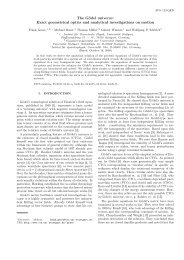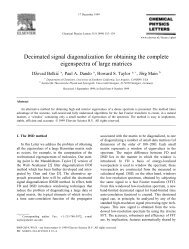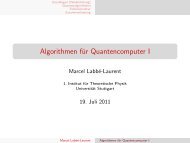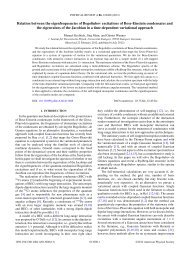2.6M - 1. Institut für Theoretische Physik - Universität Stuttgart
2.6M - 1. Institut für Theoretische Physik - Universität Stuttgart
2.6M - 1. Institut für Theoretische Physik - Universität Stuttgart
Sie wollen auch ein ePaper? Erhöhen Sie die Reichweite Ihrer Titel.
YUMPU macht aus Druck-PDFs automatisch weboptimierte ePaper, die Google liebt.
Summary<br />
Jastrow factor was chosen in accordance with the estimate corresponding to equation<br />
(3.70) and figure 5.76 in section 5.2.2. A horizontal solid line is printed in the figure if<br />
other methods provide a comparable value. The quoted energy value in the caption of<br />
each figure is the RPDQMC ground state energy value; the error gives the variation of<br />
the block energy EB according to equation (4.3). This chapter also states the dependence<br />
of ∆τ (see figures 5.74 and 5.75) and b JF (see figure 5.76). It is observable that ground<br />
state energy increases slightly for smaller ∆τ but the statistical error increases too.<br />
The implementation shows that ∆τ may not be chosen arbitrarily small. Regarding<br />
the acceptance probability it can be said that a great acceptance probability leads to<br />
a large standard deviation, and a small one to instabilities. Therefore ∆τ is chosen in<br />
such a way that the acceptance probability does not sink below 98 % . The figures for<br />
the Jastrow parameter b JF show a very good agreement with equation (3.70); it is not<br />
advisable to choose a smaller b JF . Therefore the DQMC method b JF = √ β is set. The<br />
chapter closes with a view on computing time (see figures 5.77 up to 5.80) increasing on<br />
the whole with the cube of the number of electrons N .<br />
Conclusion and outlook: It is obvious that the Diffusion Quantum Monte Carlo<br />
method can also treat problems with greater atomic number than Z = 2 in the presence<br />
of an external magnetic field. In regions where values for comparison are available for<br />
an upper bound [8, 14] these values can be improved. Of course this method can also<br />
calculate ground state energies for other magnetic fields and for ions. This is done in an<br />
ongoing diploma thesis [25]; as a foretaste, for Fe 13+ results are given in figure 6.2. Figure<br />
6.1 shows the scheme of this program. Only the short-time approximation is applied<br />
but the influence can be neglected because of the tiny steps in ∆τ. Table 6.1 gives an<br />
overview of the released-phase DQMC values. These values are the most comprehensive<br />
and accurate ground state energies of medium-Z atoms up to iron (Z = 26) in neutron<br />
star magnetic fields presented in literature.<br />
An extension of the Quantum Monte Carlo method to calculate excited states was proposed<br />
by Jones et al. [10]. Note that it is always possible to extract one excited state<br />
by choosing a guiding wavefunction perpendicular to the true ground state. This is the<br />
ground state within a sub-space. But in this context they are not to be understood as the<br />
excited states. In the past excited states for helium (Z = 2) could be calculated in low<br />
magnetic fields by means of this approach. The idea of the method is to create a basis<br />
set of functions and to formulate a generalised eigenvalue problem. The diagonalisation<br />
of these matrices as a function of projection time leads to the ground state and some<br />
excited states simultaneously. The numbers of excited states are given by the number<br />
of basis functions minus one. These basis functions can be realised by several input files<br />
for the HFFEM calculations by using different quantum numbers. This idea offers the<br />
opportunity of obtaining highly accurately calculated excited states of heavy atoms or<br />
ions in strong magnetic fields.<br />
132


